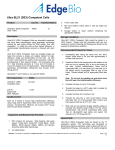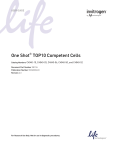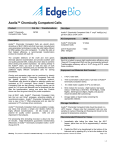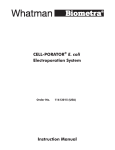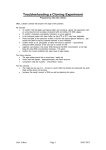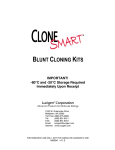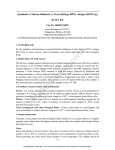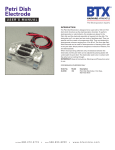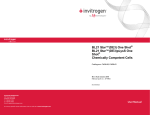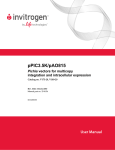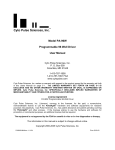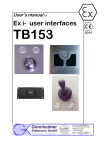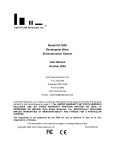Download ElectroEB10B Competent Cells
Transcript
ElectroEB10B Competent Cells Product ElectroEB10B Competent Cells Cat. No. Transformations 12573 30 5. LB-agar selective plates or selective liquid medium 6. Pipettors Storage Conditions Description ElectroEB10B Competent Cells have been manufactured using a proprietary technology rendering the cells highly efficient for DNA uptake when used in an electroporation device. To utilize the cells at their highest efficiency, a recommended transformation protocol is included with each kit. ElectroEB10B Competent Cells are only provided in tubes. All kits include a test plasmid for quality control purposes. Each tube contains pre-dispensed cells in 100µl aliquots, enough for 5 transformations using the recommended transformation protocol. Full processing time, including recovery, is about 1 hour to ensure the highest level of transformation. Edge BioSystems guarantees transformation 10 efficiencies exceeding 10 cfu/µg pUC19. ElectroEB10B Competent Cells should be stored in a -80ºC freezer. Please note that competent cells are very sensitive to cycles of freezing and thawing and should not be exposed to temperature variations. Recommended Protocol for Tubes 1. Place tubes in ice and wait approximately 5-10 minutes until they thaw. 2. Chill 1 microcentrifuge tube and 1 electroporation cuvette on ice for each sample. 3. When thawed, mix cells by gently tapping the bottom of the tube. Aliquot 20-40µl of cells into each chilled microcentrifuge tube. Control reaction: Use 20µl of cells for the control reaction. Excess cells can be refrozen in a dry ice/ethanol bath and returned to the -80°C freezer. Genotype: F- mcrA ∆(mmr-hsdRMS-mcrBC) Φ80lacZ∆M15 ∆lacX74 recA1 endA1 araD139 ∆(ara, leu)7697 galU galK λrpsL nupG tonA. Kit Components 12573 ElectroEB10B Competent Cells 6 tubes pUC19 Supercoiled DNA, 100ng/ml 1 tube Note: Refrozen cells will have reduced transformation efficiency. 4. Quality Control Each lot has been tested to assure high transformation efficiency using 10pg pUC19 supercoiled DNA and the recommended protocol. Transformation efficiency will exceed >1010 cfu/µg pUC19 under these conditions. Note: Do not mix by pipetting up and down since that will lower the transformation efficiency. Mix and electroporate only 1 sample at a time. 5. Equipment and Materials Not Provided SOC medium for recovery: 20g/l tryptone, 5g/l yeast extract, 10mM NaCl, 2.5mM KCl, 10mM MgCl2, 10mM MgSO4, 20mM glucose (MgCl2, MgSO4 and glucose should be added after autoclaving) 2. An orbital shaker 3. An electroporation device with 1mm cuvettes 4. 14ml round bottom transformation) tubes Immediately transfer cell/DNA mix into a pre-chilled electroporation cuvette. Note: Do not introduce bubbles into the sample. 1. culture Pipette the DNA to be transformed (1-5µl) to the bottom of the tube and mix by gently tapping the bottom of the tube. Control transformation: Dilute pUC19 supercoiled DNA 1:10 with sterile H2O, then add 1µl of the diluted pUC19 supercoiled DNA to one of the tubes. Discard diluted pUC19 supercoiled DNA after use. (1 tube per 6. Electroporate samples using the following conditions for the BioRad GenePulser® II: 2.0kV, 200Ω, 25µF. 7. Add 1 ml SOC medium to the cuvette and transfer the sample to a 14ml round bottom tube. 8. Transfer the tubes to a shaking incubator and then shake at 300 rpm at 37°C for 1 hour. Warning: This product is intended for research use only. It is not to be used for diagnostic purposes in humans or animals. Page 1 of 2 9. Dilute samples as necessary with SOC medium. Control reaction: Dilute the pUC19 control reaction 1:100 with S.O.C. medium. 10. Spread 100-200µl of sample on pre-warmed LB-agar selective plates or inoculate into selective liquid medium. Control transformation: Spread 50µl on LBampicillin agar plates and expect 50 colonies (>1010 cfu/µg pUC19). Notes: a. Transformation efficiencies for ligation mixtures will be 10-100 fold lower than pUC19 supercoiled DNA ligations. It is important to remove salts and buffers from any samples prior to electrotransformation since they will inhibit electroporation. Ligation reactions should be ethanol precipitated or diluted before electrotransformation. Ligations can be diluted 1:5 with dH2O. Excess salt, buffer or DNA can cause electric arcing. b. Using an electroporator other than the BioRad GenePulser® II may require setting adjustments in order to obtain the optimal efficiency for that specific model. c. Calculating transformation efficiency 6 (cfu on control plate) / (pg of supercoiled vector) x (10 pg / µg) x (final dilution) = cfu / µg DNA (Note: cfu = colony forming units) For example, if the control reaction plate has 50 colonies when 50µl of diluted reaction is plated then, 6 (50 cfu) / (10pg) X (10 pg) / (µg) X (1 ml) / (0.05ml 2 plated) X 10 = 1.0 x 1010 cfu/µg pUC19 DNA Warning: This product is intended for research use only. It is not to be used for diagnostic purposes in humans or animals. Page 2 of 2


